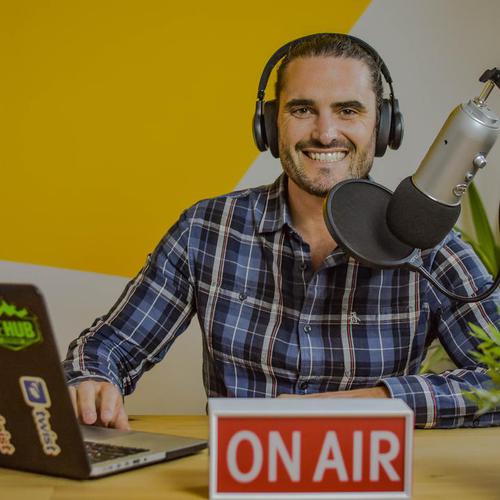We’re recording more video than ever before, but are we actually using it? How many recorded meetings or webinars have you actually sat down with?
Video is a powerful medium. But it also takes a long time to sort through. Imagine you missed a big team meeting that went on for more than an hour. But it was recorded. You need to get caught up on everything, but does that mean you need to sit and watch the whole thing?
Humphrey Chen is the CEO of CLIPR.ai, and is trying to solve this problem.
Send me the notes
Humphrey wants to see a world where meetings can be realtime-optional. If you aren’t going to change the trajectory of the meeting, but still need to be informed, you should be able to catch up afterwards.
But your options are either to sit down and watch the whole thing, or else be reliant on someone else’s notes. They might miss something, or have their own bias.
Imagine getting impeccable notes from the meeting, and also being able to see and feel a key moment when the strategy shifted.
Making video more useful
There are lots of ways that we need to make video much more useful in a digital workplace.
- All hands meet can be summarized and outlined
- We can get a better sense of the voice of the customer by measuring sentiment
- Salespeople can get more accurate feedback from sales calls
- Hiring and onboarding can take longer videos and shorten them into minutes
It’s strange to say that video is an untapped resource because we generate so much. But we have a long way to go. In the same way that we can summarize a long book into five pages of notes, we should be able to do the same with video.
Links
Welcome back to The Digital Workplace podcast. Today, our guest is Humphrey Chen. He is the CEO of CLIPr.ai. Hey, Humphrey. How are you today?
All right, very good. Very good.
I’m excited to be talking with you. We’ve got a lot of cool topics. Mostly we’re talking about the role of video in a digital workplace and how it’s underused. But before we get into that, you’re a smart guy. And I just want to make sure that you’re an actual human and not a robot that’s talking to me. So my question for you is, what is your most memorable recent meal?
Yeah, so I happened to come across a picture of it recently, too. And I think I’m a fan of Peking duck, and my wife, you have the option where you can just get all the stuff prepared. But you can also get the actual duck itself that the carvings came from. And so my wife got me that. The legs on the duck are quite big. And so I started chowing down on that. And it looks like I’m Barney Rubble caveman eating a giant leg. So that was a recent and memorable and tasty, but colorful, colorful memory.
Excellent. Cool, I like that. That’s a very human response. I like that. That passes the test. We’re talking about video today. But tell us a little bit about CLIPr, what it is, and what kind of problems you guys are solving.
Yeeah, so CLIPr, our operating premise is that not all minutes of video are created equally, nor are they equally relevant to everyone. And yet, when you hit play, you’re at the mercy of what’s behind that play button. And when it comes to your own personal content, and this might be a Zoom recording, a Teams recording, or a Meet recording, or one that you experienced from any event, right now, you just might know the title. And you probably know the title, but you don’t know the rest. And so what CLIPr does is we make it fully searchable. And then for premium content, we actually create an automated table of contents, which allows you to pick and choose exactly which parts of the video you want to watch, and which parts you don’t want to watch. And so if you only care about 5%, let’s let you watch just that 5%. If there’s another 5% that you don’t know that you need to know and you want to search and find the other 5%, then we can actually help you find that 10%. But we will have saved you 90%. And so our goal at CLIPr is to let you watch just what you want. Our focus and our mission is really to basically help people to do more, and watch less. Right now, people are watching more than necessary. And it takes a toll. And it’s also not the best use of time.
So this brings up a big issue I feel like which everyone I think is dealing with but they don’t realize they’re dealing with, which is what do we do with all this video. We’re in these situations, we’re having Zoom calls, we’re trying to be more personal, trying to increase the fidelity of our conversations by adding video in. Then there’s this awesome little button that says record. So we said, okay, cool, we’ll record this conversation so that maybe someday somebody else is going to use it. But when we do that, especially the nature of video, it takes a long time for humans to process, like you said, that’s not all created equal. There’s certain moments in a conversation that stand out is like, wow, I wanted to be there. I wanted to see that. But if I have to sit through 90 minutes of a meeting to find that, that’s just too much. No one’s going to do that. So why is it, and help us understand from your vantage point, why is a video so valuable yet so worthless at the same time?
Yeah, it really has to do with the fact that this use case pre-pandemic, if you just think about how many video recordings that actually existed before the pandemic, it was like fractional single digit percent, because high value meetings were getting recorded, but medium value weren’t getting recorded. And there was good reason because previously, nobody in their right mind would actually be in a conference room and allow for a camera to record the sides of people’s heads. Just everybody would say, mo way are you going to be recording this. But now people are realizing that if you prevent someone from recording the meeting, you’re preventing someone who couldn’t make the meeting from getting any utility from the meeting, even though there might actually be a very low probability that that person actually ever ends up watching it.
The problem with video today is that it’s big. It takes time. It takes a lot of CPU GPU to actually process efficiently. And so the tools haven’t caught up with the behavior. Because we’ve gone from fractional single digit percent of meetings getting recorded out of the 50 million a day happening every day to double digit percent, but that double digit percent, the odds of someone actually accessing it are really, really low. Because if you have to go through the thought process of, do I watch what’s on my Netflix queue or do I watch the meetings that I missed and get caught up? Which one’s going to win? I mean, it’s like one is entertaining and one is painfully searching and finding what you need and value. Even if you’re using other utilities, they’re fragmented. And so the ability to basically do a Google-like search in your video, and just find exactly the stuff you’re looking for, makes it effortless, makes it super targeted. And so it’s actually really hard work. And this is the kind of stuff that people in movie studios would have access to. But we’re bringing the power of what movie studios have been using to find and sort and edit and create movies efficiently to everyday content.
And so these tools just haven’t been available. And now they’re starting to, we identified the need last May, we created the company in July, the tools within Amazon, within machine learning allow us to like get to market much more quickly. And so this power, we can actually make it available to everybody. And so we’ve started off with powering event platforms. We’re also focusing on enterprises. Initially, we thought, hey, maybe this could be useful for students. And it still can be useful for students. But one of the things that we discovered with students is that parents didn’t actually value saving time for their kids. And teachers didn’t value saving time for kids either. And so if nobody values it then it’s like, okay, well, that’s not good market fit.
Yeah, that’s a different problem, Humphrey. We’ve got to solve that problem first.
Yeah. So we basically wanted to focus on bigger problems. And so what we realized, and part of the reason we initially started, our MVP ended up processing Amazon’s Reinvent, because there were hundreds of hours of content there. And normally, what would have been a three-day, four-day dedicated event in Vegas ended up being a two-month event spread across three weeks interspersed with everyone’s everyday activities. And what normally would have been a 50,000 event ended up being a 500,000 person event spread out across all different time zones. And so the challenge that event organizers have is that their people, you can’t have them all watching at the same time. And so this post event and asynchronous experience, which used to be an afterthought, ends up being really, really important.
And that same thought process for events content, which is like one to many, actually also applies to everyday content in businesses, but the pain point in the events is really, really high. And the need for referential utility is also really high in the events world and high value content. And so for us, we’ve all been just focused on, hey, how do we make this easy? And how do we make this, we want people to find exactly what they need, just in, out, done. But it’s been fun because, it’s weird to feel pandemic opportunistic, because in a way, if this hadn’t happened, and we didn’t have workplaces getting meaningfully accelerated digitally, the need for what we’re doing wouldn’t have existed. And now, even as the vaccines have rolled out and we’re feeling safer, a lot of the practices that we’ve grown accustomed to are still intact. And so it’s been exciting to evolve and see how people are reacting to the new needs.
Like you said, video was always, a recorded video was an afterthought, like, oh, yeah, maybe we’ll just throw that in as a bonus thing that no one’s ever going to do. And how many times have all of us signed up for a webinar or some conference, and then had a conflict or realized we wouldn’t be there and our best intentions say, yeah, I’ll check out the recordings afterwards, but then we never do it. And they just sit there. And so it’s like, how do we actually bring that back in? And like you said, too, the tools have not caught up with where the technology is.
Yeah, and it’s only because the need didn’t become meaningful enough until recently. So in a way, things get built once the needs become bigger, and some people end up seeing what these needs are earlier and then jumping on it, and that’s just how things work.
I think the best tool we had before was just you can make it 2x instead of 1x. That was your option. If you want to really try to scan through what’s going on, whether it’s audio or video, and still, then you’re just thinking through what’s going on. So, yeah, this is a great thing. Let’s talk about bringing into the work context, just within meetings. I know one thing that we’ve talked about before is about this idea of real time optional, which means that you’ve got a meeting, maybe something needs to be discussed, we’d like to say, okay, if you’re going to have a meeting, get the best out of that meeting, which means there are certain things, certain people that need to be involved in that, that you need that quick collaboration on that you’re just not going to get an asynchronous environment. But that doesn’t mean that everybody has to be there. The whole team needs to be there, again, you look around, there’s 20 people on a call, but only four people are really talking and driving the conversation. How does something, a tool like this, actually make that situation better?
Yeah, and I mean, in this movement that I want to help make happen around real time optional, really comes down to the fact that within any meeting that you’re attending, if you’re an active contributor, and you’re going to change the outcome of the meeting based on your participation, then you’re real time required. If you’re going to be a fly on the wall, and listening, just in case you might need to know something, well, that’s actually real time optional, because you can actually do that synchronously or asynchronously. And so the way that we’re thinking about with CLIPr is, imagine if Outlook or Google Calendar had a new setting. And it was not just required versus optional, but also real time optional. If it’s real time optional, then it means that you’re automatically going to get a copy of the recording, and you’re going to be able to find it and refer to it and get what you need from it.
And so if someone thinks about inviting people with that view, it allows for people to actually really decide whether they need to be there or not. We’ve all heard about video fatigue, and a lot of it has to do with the fundamental aspect of being in more meetings than necessary. And if you end up being in just those meetings where you’re absolutely critical, then you can be a lot more focused on how your day is spent. Part of CLIPr‘s motto is to focus on the moments that truly matter. And those moments that matter are going to be the ones where you’re influencing and changing the decisions, and/or making decisions based on collaborative conversation. And so imagine this view of the world where you can basically say, well, hey, I can’t make it, I’m real time optional. I’m going to CLIPrize it.
And at that point, pre-CLIPr, the odds of you actually getting caught up would have been really, really slim. But now, if it’s integrated with your Zoom account, if it’s integrated with your Teams account, integrate with your Meet account, it’s actually highly probable, and it’s actually verifiable that you did get caught up. And so it ends up being a whole new way of working where you can actually be rest assured that that person actually will get caught up, because right now, when it’s like, oh, send me the recording, you have no idea whether they actually watched it, and whether they actually watched the most important part. And if they didn’t, then you actually could actually tell them which moments you actually really wanted them to see. At that point, it’s just saving time all around. So these tools are going to get smarter and allow for things to happen. Imagine if it’s a group meeting, and everyone is jumping into that video, and reacting to specific moments, and then it’s getting shared more broadly, everybody can actually look at those areas of the video where there’s the most engagement and the most reaction and that becomes a filter around what’s necessary versus what’s not necessary.
Yeah, and when I think about what real time optional is today, that means that, like you said, there’s two spectrums. One is here’s the entire recording. Good luck, watch it, knowing that no one’s going to watch it. The other is, hey, I took notes in the meeting, which is great. Somebody being able to give a textual version of the too long, didn’t read, or I guess it’s too long, didn’t watch now, of the meeting is fantastic. But we have to recognize there’s bias built into when an individual creates those notes. One, sometimes people just forget to do it, they’re in the middle of a conversation, they’re in the heat of the moment. No one’s typing. They’re talking about it. And it takes a lot of discipline to step back and write that out. So one, you might miss stuff. And the other is it’s going to go through one person’s filter, they get to decide what was important through that when they get the note. So I think notes is a great thing, it’s a best practice, we should be doing it. But if that’s the only thing you’re relying on, you still might be missing things.
Yeah, and it’s not an accident that one of our future features will be CLIPr notes. So it’s like a play off of the Cliff Notes. Right now, you’re right, because when people end up sending their notes, it’s from their view of the world. And so you’re actually seeing their notes from what they think is important, which may or may not be what you think is important. And so there’s built in bias on that. And right now, it’s probably been good enough. But when you think about stuff at scale, that’s where stuff can go off the rails. And so it requires a lot of effort and diligence, and a certain percentage of the population will do that. Our goal here is to just make it a lot easier for everyone to do it.
Let’s get into some other things. So I think we usually think about meetings and webinars in this context. But what are some other things where video actually gives us a big native advantage? We talked about native advantage of digital tools. Like you said, before, no one was recording videos of any meetings. And now we’re recording all sorts of stuff. So what are some other opportunities that we’re missing that video is actually bringing in that if we were to have more advanced tools, we could get more value out of those?
Yeah, so right now the no-brainer entry point for CLIPr has been all hands meetings, because they end up being high value. Granted, most people end up attending, but it ends up also being one of those things where it has referential utility. And so when you can search it, you can find moments, because a lot of times, new features, new products, new major hires get highlighted, and so people will want to refer to that retroactively. And so all hands has been a very, very natural starting point.
But another use case that has emerged is video voice of the customer. Many customers have started to record all customer meetings, because what ends up happening is that if you’re a customer success or a field or a salesperson, and you actually are interacting with a customer, and the customer says something really negative or something really positive, and you go back to headquarters with that feedback, many times that messenger gets accused of sugarcoating, or exaggerating. But when you actually have the actual recording of the customer, that becomes a documented video source of truth. And so now, everybody can look at that moment in time, and see exactly what was said, which allows for full accountability end to end. And what used to be a memory is no longer a memory, it’s actual recorded reality. And so if you now have these video moments that can actually be made available exactly when you need, it really prevents any distortion in any way. And that’s another example.
Another example that we’re working with another customer is hiring and onboarding. So recruiters are now requiring that interviews be recorded. And so now you can imagine that if you’re then deciding whether to hire or not hire, and the person said, this was a hire moment or a no hire moment, because this person answered the question really well and here’s how that person answered the question, you can actually hit play. And now everybody, all those recruiters and other hiring managers can all look at it and go, wow, that was really well done. And now their bar just got raised to that level because they just saw that actual moment, as opposed to hearing it and interpreting it the way they want to interpret. So recruiting voice of the customer, recruiting is another example.
So that’s two examples. But even on the voice of the customer, there’s another play that actually ties in nicely, which is to say, if you ever talk to a salesperson, there’s no salesperson that will ever come back and say that the meeting didn’t go well. Every sales call goes well, but not every sales call turns into an actual sale. So we can then also use that not only for the video voice of the customer, we can actually use the sentiment to actually forecast the actual probability of the sale based on the sentiment conveyed by the customer. And that ends up being varying degrees of sentiment. The vision aspect, what CLIPr does, in addition to the audio aspects, allow for deeper analysis around very specific roles that can be correlated back to business value. And so right now we’re getting ready to really the opportunity for your listeners for the audience says, hey, if you can come up with a use case that we can actually help make happen for you, we would love to make it happen. We’re really focused on early adopters that are going to be proud to talk about these design wins, that we can actually quantify how it has meaningfully improved their business.
Telemedicine is another example, hey, before you had EMR and medical notes for the doctor and the patient. And now if those meetings are actually also, those patient visits are being recorded, it’s not useful if nobody’s easily able to refer to it. A URL inside their file, a doctor’s file for a patient visit, is not as useful as being able to search the name and search for the statement and search and jump right to that actual moment and refer to it to supplement the normal notes. And so this video explosion, now we’re just like, one of the things that we’ve had to do is focus on these high value moments that have high business value, because the challenge is there’s so many opportunities that there’s not enough hours in the day to pursue all of them. So we actually have to focus on the biggest highest value ones first, and then over time get to more and more of them.
Yeah, I’m so glad we’re having this conversation, because I feel like most people in leadership and digital organizations, they’re like, okay, video is important, but they don’t see or not thinking about the opportunities, and I feel like this conversation will help them see like, oh, yeah, you’re right. We could be using it for that and for that, and like you said before, before all this happened, who would ever agree to have all their sales meetings recorded? No one. That was just ridiculous. You’re not recording my meetings, but now it’s like, yeah, sure. Go ahead.
I mean, and now I think we’ve reached a point where it’s similar, where we’ve all dialed into a call center and it’s like, this call is being recorded for quality control purposes. And so, now we’ve grown numb to recording even on the video, and when someone says, yeah, can you record a video, you’re like, sure, I mean, everyone’s already careful about what they’re saying. And they know when it’s being recorded, they have to be even more careful. But now it’s like the tools for referential utility are more important than ever because just because you recorded it doesn’t mean you’re going to get any utility out of it, if they just end up being huge storage costs that nobody can ever access or unleash or unlock.
I’m excited about a lot of the things you said. I was thinking about the all hands thing. And there’s always moments in a company’s history that are just really important. And a lot of them happen at these all hands meetings or something like that. And I was thinking even in terms of onboarding new employees, you could almost think about creating a highlight reel to show new people when they jumped in and said, this one moment was very pivotal in our organization. Here, take a look. And you got it right there. And they don’t have to sit through hours of all hands meets trying to find those things, but you can actually bring people into the context of that company through those key video moments.
Yeah, no, absolutely. And it’s like we’ve all been in these new employee orientation meetings, and you have leaders coming through. And a lot of times, they’re saying the exact same thing. It could just be a recording that actually just gets played. And then there could be selective live moments to actually complement the prerecorded moments. Part of the problem, what we’ve witnessed is the skills for Adobe Premiere Pro, it’s in the video editing room. And so your average person with everyday video, work related video doesn’t know how to edit these videos. And so you have these blocks of 16 minutes of video that nobody can actually cut, splice, and move around. And something like CLIPr helps to find those individual clips, helps to make them shareable and reusable. And it doesn’t require professional video editing skills, and then it can be done in seconds, not in hours with expensive people editing this stuff. And so yeah, and I think these highlight reels actually is part of what prompted the realization for the opportunity around CLIPr because just like professional media and networks have the need to create sports highlight reels, now everyday workers have the need to find those highlights.
Yeah, that’s a great point. I like how you mentioned that before, like Hollywood and other places that have had access to these things before, I mean, think about the people that have to, are they actually sitting there watching three hours of a football game to find the highlights? No, they probably got some shortcuts in their pocket that they’re using for these kinds of things and we can have access to those things.
Some of them do. And some of them don’t. But in that case, the content is so high value, that it’s worth having someone look at it full time to find that stuff, because it’s servicing a whole population or the whole country. And, yeah, so in a way, these powerful tools, it’s like the democratization of computer vision to enterprises and to businesses, because it’s one thing to provide an API to let a developer see and hear at scale, like CLIPr is trying to, is basically providing a solution to let anybody see and hear at scale, like anybody who has a link to a video, and that video could be a Zoom link, a Teams link, a Meet link, or something you got from following an event. But for a developer, it could also be an S3 bucket. I mean, in that case, and someone who has an on-premise system, they could call a CLIPr API, and process all their content per their rules and their requirements within their enterprise.
And so that’s why we’ve created this whole category, which is basically a VAM, video analytics and management platform, which says, hey, CLIPr is end user friendly, but it’s also a tool that allows anybody to process any kind of video that they have, wherever it is, we want to support it. And we’ve basically built CLIPr as if anybody built it, because what we’re charging, it’s as if they built it, but we’re not charging them what it costs us to build CLIPr because we’re actually very much focused on providing business value and building new machine learning models based on the data and learning and improving from everything that we learn.
Yeah, well, it sounds great, Humphrey. Where should people go if they want to learn more about it?
We’ll have it in the show notes so everyone can check it out. But please do. And think about your video. Think about what you’re doing with it. Think about how you could be doing more with it. You’re going to need some more advanced tools to do those things. But for sure, it’s an opportunity we need to explore more. Humphrey, thanks for being on the show. We look forward to connecting with you again soon and learning what the next world of video looks like.
Yeah, thank you so much and thanks for helping us to save a billion hours for everybody.
Seasoned big picture thinker who can go both deep and wide specializing in the use of technology to make people and companies more productive. Can make difficult concepts easy to understand and speak on a range of different wave lengths depending on the stakeholder. Solid relationship development skills which instill trust & confidence over time with whomever he works with. A solid and dynamic communicator with a positively viral passion for spreading whatever he is focused on and trying to make happen.












